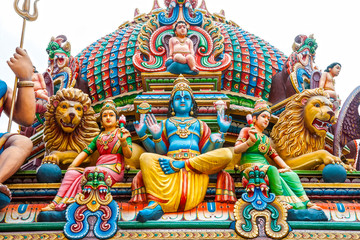MAIN 6 RELIGIONS IN INDIA : The belief in a divine entity...!!!
Religion has historically influenced Indian society on a political, cultural and economic level. There is a sense of pride associated with the country’s rich religious history as the traditions of Hinduism, Buddhism, Sikhism and Jainism all emerged out of India. Moreover, while a majority of people in India identify as Hindu (79.8%), the medley of religions that exist within the country continually impact contemporary society.
In India, religion is more publicly visible than it is in most English-speaking Western countries. This becomes evident when considering the numerous spaces that are thought to be sacred and holy. Examples include ‘ashrams’ (monasteries or congregation sites) consisting of large communities of scholars or monastics, temples (mandir), shrines and specific landscapes such as the Ganges river. There is a rich religious history visible in architecture, and it is not uncommon to find various places of worship, such as a Hindu temple, Muslim mosque and Christian church, all next to each other.
– 80% of the population is Hindu. Other religions include (the percentages are rounded):
– 13% Islam (The Muslim population is spread throughout the country)
– 2% Christianity (in Kerala, Goa, Tamil Nadu and Meghalaya)
– 2% Sikhism, (Punjab region)
– 1% Buddhist (in the Maharashtra area)
– 0.4% Jainism (in the regions of Maharashtra, Rajasthan, Gujarat, and major cities)
– 1.6% Other (Judaism, Zoroastrianism, Bahá’í, tribal religions).
1.Hinduism in India
Hinduism – the most widely followed religion in India – can be interpreted diversely. Pinpointing what constitutes Hinduism is difficult, with some suggesting that it is an umbrella term that encompasses various religions and traditions within it. Nonetheless, Hinduism in all its forms has been particularly influential in Indian society.
Social Structure
One influential component of Hinduism impacting India is the large-scale caste system, known as the ‘varna’ system. The varna caste system represented the Hindu ideal of how society ought to be structured. This form of organisation classified society into four ideal categories: brahmin (priestly caste), kshatriya (warrior, royalty or nobility caste), vaishya (commoner or merchant caste) and shudra (artisan or labourer caste).
It is a hereditary system in that people are believed to be born into a family of a specific caste. Each caste has specific duties (sometimes known as ‘dharma’) they are expected to uphold as part of their social standing. For instance, a member of the Brahmin caste may be expected to attend to religious affairs (such as learning religious texts and performing rituals) while avoiding duties outside of their caste, such as cleaning. In contemporary times, Brahmin men who have been trained as priests often tend to temples and perform ritual activities on behalf of other members of Hindu society.
2.Islam in India
Islam is the second most followed religion in India, influencing the country's society, culture, architecture and artistry. The partition of the subcontinent in 1947 led to mass emigration of roughly 10 million Muslims to Pakistan and nearly as many Hindus and Sikhs from Pakistan into India. This event changed the demographics of both countries significantly and is continually felt throughout India.
Nonetheless, the Islamic community in India continues to play a considerable role in the development of the country. For example, the Muslim community in India has contributed to theological research and the establishment of religious facilities, institutes and universities. The mystical strain of Islam (Sufism) is also popular, with people gathering to watch Sufi dance performances. The majority of Muslims are Sunni, but there are also influential Shi'ite minorities in Gujarat. Most Sunnis reside in Jammu and Kashmir, Uttar Pradesh, West Bengal and Kerala as well as major cities.
3.Sikhism in India
Originating in India, Sikhism is a monotheistic religion that promotes devotion to a formless God. The religion is centred on a tenet of service, humility and equality, encouraging its followers to seek to help those less fortunate or in need. For example, it is common for Sikhs to offer food to those visiting a gurdwara (the primary place of worship for Sikhs). One of the most recognised symbols of the Sikh community is a Sikh turban (known as a ‘dastar’ or a ‘dumalla’) worn by many men and some women. Since the partition of India and Pakistan, most Sikhs in India have resided in the Punjab region.
4.Buddhism in India
5.Jainism in India
6.Christianity in India
Christianity is the third most followed religion in India, mostly concentrated in the far south and Mumbai. The most prominent denomination of Christianity in India is Roman Catholicism, but there are also localised Christian churches (such as the Church of North India and the Church of South India). Converts to Christianity have come mainly from traditionally disadvantaged minorities such as lower castes and tribal groups.








0 Comments